Air control devices are used in ventilation to control air flow or to set up equipment. This category includes both plastic air valves for apartment ventilation and giant heated and electrically operated mechanisms for industry. The efficiency of air ventilation depends on the correct selection and placement of control devices.
Purpose of air control devices
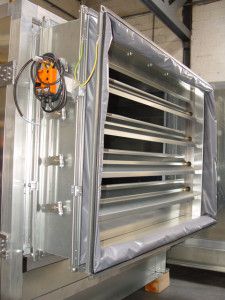
Air dampers and ventilation valves are used for:
- air flow control;
- overlapping ventilation ducts during system shutdown;
- debugging work;
- debugging of air flow rates in ventilation ducts.
Air valves are required to stop air flow through the ventilation ducts when the system is stopped. Modifications of air dampers for ventilation with adjustable stops (throttle valves) that change the air flow have been developed. Standard type throttle valves are installed in air ventilation systems with a pressure of not more than 1500 Pa and a concentration of mechanical impurities up to 100 mg per cubic meter.
It is advisable to install air valves in systems with an air temperature not higher than 800 degrees Celsius and an aggressive environment comparable to the quality of atmospheric air. In regions with cold climates, electrically heated models have been developed for ventilation of air compressor units.
Ventilation dampers regulate the amount of air supplied to ventilation systems.
Types of ventilation valves and dampers
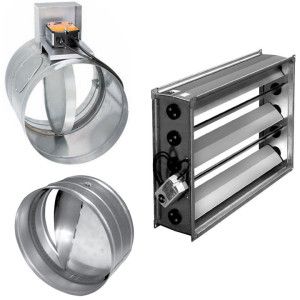
The main types of air control devices are air dampers and dampers. No ventilation system, be it an air compressor station, an office building or an entertainment complex, is complete without these mechanisms.
In terms of form and function, ventilation air valves are:
- round;
- rectangular;
- reverse;
- fire-fighting;
- smoke removal.
Round valves for ventilation
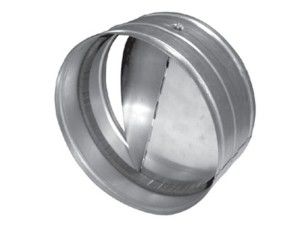
They are used in circular air ducts and are made of galvanized sheet metal 0.5 - 1 mm thick, resistant to moisture. The design of the valves is a round metal body and a damper. The damper is controlled by a mechanism located on the side. If the position of the damper is adjusted manually, the model name contains the letter "P", if the pneumatic drive is connected - "P", the electric drive - "E".
For small-diameter air ducts, manual air dampers are more convenient. Large diameter valves are electrically controlled. Such valves change the intensity of the air flow or completely shut off its movement when the system stops. The damper blade can be held in the required position. It is covered hermetically and passes no more than 10% of the air, since it is equipped with a seal around the perimeter.
When adjusting the pressure, the damper is set in a certain position. Round air dampers for ventilation in the apartment and in production are produced in diameters of 25 - 125 cm. They are produced in a standard length of 5 - 7 cm, depending on the diameter. And the throttle bodies are 23.5 - 123.5 cm.According to GOST, they can be operated at a temperature of -30 ... +400 degrees Celsius, covered from snow and rain.
Rectangular ventilation valves
They are installed in rectangular air ducts and are used at temperatures of -30 ... +70 degrees. The main material for their production is sheet aluminum, rectangular dampers are sealed with a rubber band. In accordance with the name - a shut-off-control valve, they can change the flow rate or completely shut it off.
The smallest rectangular choke valves are available with a diameter of 15 x 15 cm, the largest 100 cm x 100 cm. For non-standard air ducts, valves are made on special order. Since choke valves can be a source of noise, it is not advisable to install models larger than 500 mm in diameter in residential, medical and public buildings. The valve is mounted in the duct with a flange and nipple connection, and a round one - and a shroud.
SVK-NS electrically heated valves are produced in a rectangular shape. This is a body with rotary louvers, at the joints of which there are heating tubes (electric heating elements). They prevent freezing of the joints
Fireproof ventilation dampers
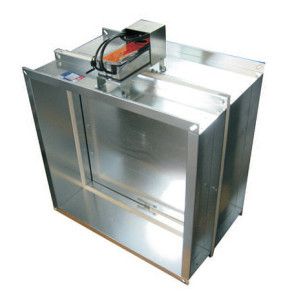
Such valves are also called fire-retarding valves and are installed in general ventilation systems. Together with a system of air locks, ventilation is mandatory according to the requirements of the fire inspectorate. Necessary for tightly closing channels leading through partitions, ceilings and walls of one floor. Fire dampers stop the spread of combustion products and fire from one room to another through the air ducts. To reverse the movement of smoke in the opposite direction, air gates are designed in the ventilation system. They prevent the penetration of fire and smoke from the lower floors to the upper ones and, in fact, are a downward branch of the air duct. The fire-retardant valves are controlled by an electric motor with a remote control or automatically. The valve is equipped with a thermal sensor that transmits a signal via an electromagnetic drive to a spring lock, which slams the leaf. Such valves are installed in rooms of category "B" for explosion hazard. In rooms "A" and "B", only explosion-proof valves are used.
Smoke exhaust valves
This equipment is installed in the smoke ventilation ducts. The valves are placed in the openings of the separating structures. Smoke exhaust air dampers quickly remove smoke and combustion products from the fire zone like ventilation air locks, reduce the intake into the smoke exhaust channel from floors free from fire. Thus, the removal of smoke is accelerated, fresh air is supplied to the premises.
Check valves for ventilation
Their difference is the presence of a spring that automatically closes the damper and shuts off the air supply in the opposite direction. Check valves are installed for ventilation in the duct by means of a nipple mount. They are made of steel with anti-corrosion coating, and the damper is made of sheet aluminum. All ventilation check valves are general purpose and explosion proof. Installed vertically or horizontally, depending on the direction of air movement. Explosion-proof check valves for air ventilation have enhanced protection against fire and sparks. They are produced in rectangular and round shapes, and are also used for ventilation of an air compressor room.
Butterfly check dampers are characterized by a centrally located pivot on which two dampers are mounted. When the fan is off, they stop the air flow in the opposite direction. This type of air valve is most often installed in the ventilation systems of apartments. For more details, see the video:
Ventilation filters
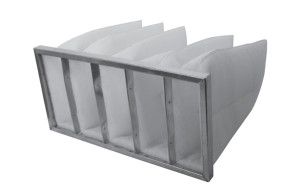
The quality of ambient air supplied to buildings by ventilation systems is often unsatisfactory. To preserve the health of people, it is necessary to clean the supply air. In industrial plants, it is often necessary to filter the exhaust air, which is saturated with mechanical and chemical impurities.
Air is cleaned with air filters for ventilation. Filters are always installed in ventilation systems of industrial enterprises, office complexes, medical centers, modern residential buildings.
Types of filters for ventilation
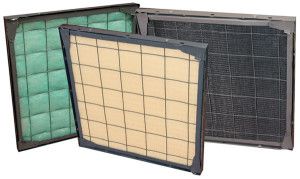
According to the principle of operation, air filters for ventilation are:
- bulk or absorbent;
- porous.
Absorbent bulk filters for air ventilation are filled with gravel, porcelain inserts, crumb rubber, activated carbon, metal crumb or coke. The filler material depends on the purpose of the building.
Porous air filters are made from small perforated strips, fabric or metal mesh. Sometimes they are impregnated with oils.
Porous filters include fabric filters made of cotton or wool.
Air filters have the ability to:
- rough cleaning - retain particles larger than 10 microns;
- fine cleaning - retain particles 1 - 10 microns;
- extra fine cleaning - retain particles 0.1 - 1 micron.
The form and content of a filter is dictated by its purpose. For example, for coarse filtration, a metal or synthetic impregnated mesh is suitable. This filter material is produced in the form of individual inserts or strips.
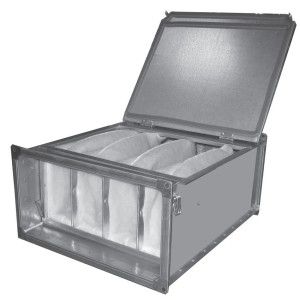
Fine filters are usually made of fiberglass. They are folded, pocket and electrostatic. A widely used filler is activated carbon, which traps mechanical inclusions, stench, and dangerous gases.
Extra fine filters are made from sheets of special submicron paper glued together or fiberglass.
In medical institutions, kindergartens and schools, combined multifilters are installed that can capture all types of impurities.
Air filters for ventilation systems are available in cassettes or panels that can be replaced. For convenience, the sizes of the earbuds are standard. And the body is made for the diameter of the duct and can be rectangular or round.
Aerosol filters
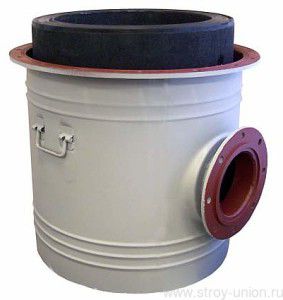
This is a separate type of air filter for ventilation systems used in exhaust systems. Aerosol filters prevent the release of harmful production products into the atmosphere. They are mainly used in the chemical and nuclear industries.
Aerosol filters provide perfect air purification in the premises of pharmaceutical enterprises and cleanrooms (where the most accurate microcircuits are produced).
To purify the air in ventilation systems, vortex traps, cyclones, bag filters, and devices for air washing are used as air filters.








